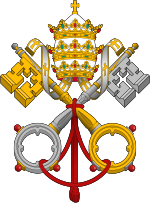Pope Fabian
| Saint Fabian | |
|---|---|
 |
|
| Papacy began | January 10, 236 |
| Papacy ended | January 20, 250 |
| Predecessor | Anterus |
| Successor | Cornelius |
| Personal details | |
| Birth name | Fabianus |
| Born |
??? ??? |
| Died | January 20, 250 Rome, Roman Empire |
| Sainthood | |
| Feast day | January 20 |
| Papal styles of Pope Fabian |
|
|---|---|
 |
|
| Reference style | His Holiness |
| Spoken style | Your Holiness |
| Religious style | Holy Father |
| Posthumous style | Saint |
Pope Saint Fabian was Pope, or Bishop of Rome, from January 10, 236 to January 20, 250, succeeding Pope Anterus.
Eusebius (Church History, VI. 29) relates how the Christians, having assembled in Rome to elect a new bishop, saw a dove alight upon the head of Fabian, a layman and stranger to the city, who was thus marked out for this dignity and was at once proclaimed bishop by acclamation, although there were several famous men among the candidates for the vacant position.[1]
He is said to have baptized the Roman emperor Philip (Marcus Julius Philippus) and his son, to have done some building in the catacombs, to have improved the organization of the church in Rome, and to have appointed officials to register the deeds of the martyrs.[2]
According to "later accounts, more or less trustworthy" according to the Catholic Encyclopedia, Fabian sent out the "apostles to the Gauls" to Christianize Gaul after the persecutions under Emperor Decius had all but dissolved the small Christian communities. Fabian sent seven bishops from Rome to Gaul to preach the Gospel: Gatien to Tours, Trophimus to Arles, Paul to Narbonne, Saturnin to Toulouse, Denis to Paris, Austromoine to Clermont, and Martial to Limoges. He also had the bodies of Hippolytus of Rome and Pope Pontian brought from Sardinia to Rome. He was made a martyr during the persecution of Christians under Emperor Decius and was one of the first to die on January 20, 250.[3]
His deeds are thus described in the Liber Pontificalis: Hic regiones dividit diaconibus et fecit vii subdiacones, qui vii notariis imminerent, Ut gestas martyrum integro fideliter colligerent, et multas fabricas per cymiteria fieri praecepit. ("He divided these regions into deaconships and made seven sub-deaconships which seven secretaries oversaw, so that they brought together the deeds of the martyrs faithfully made whole, and he brought forth many works in the cemeteries.")[2]
Although there is very little authentic information about Fabian, there is evidence that his episcopate was one of great importance in the history of the early church. He was highly esteemed by Cyprian, bishop of Carthage; Novatian refers to his nobilissima memoriae, and he corresponded with Origen. One authority refers to him as Flavian.[2]
St. Fabian's feast day is commemorated on January 20.[4]
Tomb
Fabian was buried in the catacomb of Callixtus. The Greek inscription on his tomb has survived.[1]
References
- ↑ 1.0 1.1 Attwater, Donald and Catherine Rachel John. The Penguin Dictionary of Saints. 3rd edition. New York: Penguin Books, 1993. ISBN 0-140-51312-4.
- ↑ 2.0 2.1 2.2
 Chisholm, Hugh, ed (1911). "Fabian, Saint". Encyclopædia Britannica (Eleventh ed.). Cambridge University Press.
Chisholm, Hugh, ed (1911). "Fabian, Saint". Encyclopædia Britannica (Eleventh ed.). Cambridge University Press. - ↑
 "Pope St. Fabian". Catholic Encyclopedia. New York: Robert Appleton Company. 1913.
"Pope St. Fabian". Catholic Encyclopedia. New York: Robert Appleton Company. 1913. - ↑ Gross, Ernie. This Day in Religion. New York: Neal-Schuman Publishers. ISBN 1555700454
| Catholic Church titles | ||
|---|---|---|
| Preceded by Anterus |
Bishop of Rome Pope 236–250 |
Succeeded by Cornelius |
|
|||||||||||||||||||||||||||||||||||||||||||||
|
|||||||||||||||||||||||||||||||||||||||||

